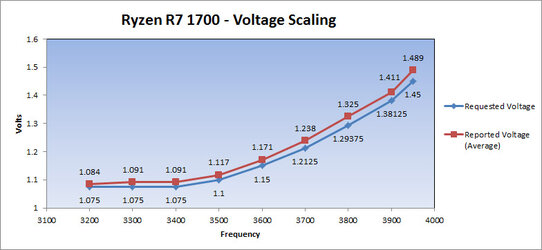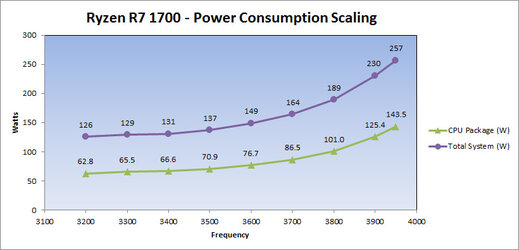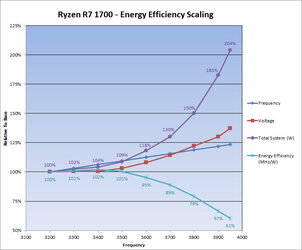-
Welcome to Overclockers Forums! Join us to reply in threads, receive reduced ads, and to customize your site experience!
You are using an out of date browser. It may not display this or other websites correctly.
You should upgrade or use an alternative browser.
You should upgrade or use an alternative browser.
FEATURED AMD ZEN Discussion (Previous Rumor Thread)
- Thread starter Johan45
- Start date
- Joined
- Jul 14, 2003
Any information or rumors about the R5 4 cores being 1 CCX module? Would hate to see it be a quad core that is 2 cores per module (2+2) and see it remain at the mercy of the current issues introduced by the CCX module structure (which isn't alot of course, just sayin)
- Joined
- Dec 18, 2000
Any information or rumors about the R5 4 cores being 1 CCX module? Would hate to see it be a quad core that is 2 cores per module (2+2) and see it remain at the mercy of the current issues introduced by the CCX module structure (which isn't alot of course, just sayin)
It wouldn't be very efficient for AMD to do that. Much simpler/cheaper to use the same CCX modules for all Ryzens.
- Joined
- Dec 13, 2015
AMD has confirmed that the six-core CPUs are 3+3 configuration, and the four-core CPUs are 2+2.Any information or rumors about the R5 4 cores being 1 CCX module? Would hate to see it be a quad core that is 2 cores per module (2+2) and see it remain at the mercy of the current issues introduced by the CCX module structure (which isn't alot of course, just sayin)
- Joined
- Mar 7, 2008
It is easier to understand the quad cores if you look in terms of CCX. Each CCX has 8MB L3 cache and a single memory channel, so if you want to provide more than that, you need more than one CCX. Further, it was mentioned somewhere the architecture is best where CCX cores are balanced, so no 4+0, or 3+1 options with two CCX. If they went single CCX, you would be limited to a single ram channel. Maybe that could make sense for R3 or other low cost applications. I'm not sure we have a complete picture of exactly what can be turned off or not yet, so maybe there are still some different configurations available, or maybe they will use something other than CCX for low end.
- Joined
- Jul 14, 2003
AMD has confirmed that the six-core CPUs are 3+3 configuration, and the four-core CPUs are 2+2.
It is easier to understand the quad cores if you look in terms of CCX. Each CCX has 8MB L3 cache and a single memory channel, so if you want to provide more than that, you need more than one CCX. Further, it was mentioned somewhere the architecture is best where CCX cores are balanced, so no 4+0, or 3+1 options with two CCX. If they went single CCX, you would be limited to a single ram channel. Maybe that could make sense for R3 or other low cost applications. I'm not sure we have a complete picture of exactly what can be turned off or not yet, so maybe there are still some different configurations available, or maybe they will use something other than CCX for low end.
Thank you guys. Good info.
I believe there is at least one different configuration available though, but that will be coming with the APUs. Given size limitations, wouldn't a quad core APU be 1 CCX module + Vega GPU "module"? Or i suppose the APUs could still be 2+2 with the remaining disabled stuff lasered off or something and the Vega module taking up that space, but i sorta feel that is less likely.
- Joined
- Mar 7, 2008
There are certainly unknowns. Good question on the APUs. Maybe the "GPU module" will also contain its own ram controller, providing another channel? Thus single CCX + GPU would still offer dual channel ram. I don't think they'd want to use two CCX cut down to provide low end CPU solutions, and a native single makes more economic sense there. We'll probably never know, but it would be interesting how many R5 are essentially bad R7s (with flaws preventing their full use), as opposed to crippled R7s (otherwise fully functional, but cut down specifically to create lower skus).
- Joined
- Jul 26, 2004
I'm begging questions such as these.
R5 should be able to have graphics and 3+3. It seems that memory speed doesn't matter so much.
Prices should be fantastic ~ pure speculation (of course)!
Thanks for posting!
We know the prices =)
- Joined
- Aug 11, 2015
I have about 85°C max under load on NH-D15 and CPU at ~1.43V. This includes that 20°C offset so real temp will be ~65°C.
Same cooler. Prime X370. CPU at 3.8 Ghz. 80° - 82° C max under load. CPU at ~ 1.37V.
It's a chunk of aluminum with a vapor chamber. It's sufficient to hit at most 3.7ghz from what I saw. It's really not bad for a factory cooler, but he 212 Evo is better.
Edit: in fairness, it's rated for 95W TDP, and if hwinfo64 is to be believed, I was using it to cool 105W TDP OC
The 1700 is only rated at 65W not 95W.
Alaric
New Member
- Joined
- Dec 4, 2011
- Location
- Satan's Colon, US
- Joined
- Jan 1, 2008
- Location
- Colorado Springs, CO
Yes, but the wraith spire is rated for 95W TDP. The other wraith (max I think?) Is rated for 125W TDP.The 1700 is only rated at 65W not 95W.
I looked quickly, and I doubt the number I saw was right, but somewhere in my search, it was claimed the 212evo was 180W TDP. That number seems totally bogus tbh.
I have about 85°C max under load on NH-D15 and CPU at ~1.43V. This includes that 20°C offset so real temp will be ~65°C.
Is that on the ROG Crosshair VI?
Had a good spread pattern on the TIM, but it was the poo TIM that comes on the stock cooler. Overall, I'd say I just exceeded it's capacity to bleed off heat. I basically pushed that poor block of aluminum to the limit. Overall, for a stock cooler, a 700mhz OC on an 8-core isn't bad. It just wasn't designed to handle 8 cores at that speed 24/7.
Do you think the cooler will burn up if you run it 24/7?
Is that on the ROG Crosshair VI?
I have Prime X370-Pro. BIOS 0504. I didn't change BIOS since I got board replacement ... actually I only tested it on single stage cooler on sunday and I'm not using it since then.
- Joined
- Jan 1, 2008
- Location
- Colorado Springs, CO
No, but a minor increase in ambient would've driven it to instability if folding or some other high intensity task. It's kinda hard to burn a block of aluminum without burning everything elseIs that on the ROG Crosshair VI?
Do you think the cooler will burn up if you run it 24/7?
Mind you this is all cores overclocked to 3.7ghz. Not turbo when thermal headroom exists.
- Joined
- Dec 19, 2000
Alright, so I've spent the past few days trying to plot out the frequency/voltage/power consumption curve for my R7 1700. Basically what I did was set the speeds to 100 MHz intervals, and then adjusted the voltage until I managed to get it Prime stable for at least 2 hours*. Once I got the stable settings locked in, I ran at each speed for 2 minutes and recorded the actual voltage and CPU package power reported by HWInfo (average over the two minute period). I also got the total system power consumption by using a Kill-A-Watt and taking the number that was displayed most often (the total power fluctuated slightly, but this should be accurate within a few watts).
*3950 MHz may not be completely stable. Based on the power/heat being produced I didn't want to run P95 for many hours at this setting when it was obvious that I wasn't going to run at this speed.
Results:



Conclusions
Obviously there will be difference in other chips, with some running faster or slower at a given voltage, but assuming this general voltage curve is accurate for the architecture, I feel like going beyond about 1.3 volts isn't worth it unless you don't care about power consumption at all. The increase in performance you get is too small compared to the extra power and heat required.
I hope some of you may find this of interest. I ordered a couple of 1800X when B&H Photo had them on sale, so I may try to plot the voltage scaling for them next to see how they stack up.
*3950 MHz may not be completely stable. Based on the power/heat being produced I didn't want to run P95 for many hours at this setting when it was obvious that I wasn't going to run at this speed.
Results:



Conclusions
- At least with this chip, going to 3.5 GHz on all cores is "free" from an energy efficiency standpoint. After that point the amount of power required for each additional 100 MHz starts to ramp up.
- I'd say 3.7 GHz is basically a "no brainer". There's a slight loss of efficiency compared to stock, but it's pretty small. The chip still runs cool and this preserves your single threaded boost level.
- 3.8 GHz is borderline: energy efficiency is worse and overall power consumption is higher, but they're still not unreasonable. Whether it's worth it depends on whether you favor efficiency or performance.
- At 3.9 GHz you see a pretty large jump in power consumption and heat produced. It takes 40 watts more and pretty high voltage for a rather marginal increase in frequency.
- After 3.9 GHz the chip starts to "go critical" and it's not even remotely worth it to push further.
Obviously there will be difference in other chips, with some running faster or slower at a given voltage, but assuming this general voltage curve is accurate for the architecture, I feel like going beyond about 1.3 volts isn't worth it unless you don't care about power consumption at all. The increase in performance you get is too small compared to the extra power and heat required.
I hope some of you may find this of interest. I ordered a couple of 1800X when B&H Photo had them on sale, so I may try to plot the voltage scaling for them next to see how they stack up.
Last edited:
- Joined
- Jan 1, 2008
- Location
- Colorado Springs, CO
Nice. I'm not sure how trustworthy HWinfo's wattage measurements are, hopefully they are correct. That took you some time!
That mirrors what I have seen. The 212 Evo caps out temp wise between 3.8 and 3.9. 3.9 is unstable due to temps, and 3.8 has plenty of headroom, or would normally seem it does. Ultimately I settled back to 3.7ghz as the 100mhz isn't worth the extra temps and voltage applied for a minor gain. 3.7 stays really cool, and keeps the noise down.
I may bump it back to 3.8ghz this weekend, I have some serious multi-threading code to run this weekend. Got a project for my prob-stats class, and I am going to essentially generate (2^81-1) data points for it. Should be interesting to see how much I can facepunch this 1700 in Linux [emoji14]
That mirrors what I have seen. The 212 Evo caps out temp wise between 3.8 and 3.9. 3.9 is unstable due to temps, and 3.8 has plenty of headroom, or would normally seem it does. Ultimately I settled back to 3.7ghz as the 100mhz isn't worth the extra temps and voltage applied for a minor gain. 3.7 stays really cool, and keeps the noise down.
I may bump it back to 3.8ghz this weekend, I have some serious multi-threading code to run this weekend. Got a project for my prob-stats class, and I am going to essentially generate (2^81-1) data points for it. Should be interesting to see how much I can facepunch this 1700 in Linux [emoji14]
Similar threads
- Replies
- 9
- Views
- 1K
- Replies
- 108
- Views
- 6K
